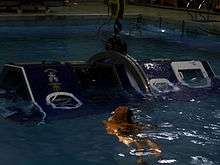Helicopter Underwater Escape Training
Helicopter Underwater Escape Training (known as Helicopter Underwater Egress Training in the United States; often abbreviated HUET, pronounced hue-wet, hue-way or you-way) is training provided to helicopter flight crews,[1] offshore oil and gas industry staff[2] law enforcement personnel, and military personnel who are regularly transported by helicopters over water.[3][4] As the name implies, the purpose is to prepare them for emergency exit in the case of a crash landing over water. While the training may be taken by crew and frequent passengers in all small aircraft that could ditch over water, a fixed wing aircraft such as a seaplane or small jet is not as prone to roll over as quickly or sink as rapidly as a helicopter with its main rotor on top of the aircraft. In addition, due to the slow speed of helicopters versus fixed wing aircraft and the lower height above the water, their cabins have a greater chance of being intact with passengers inside when ditched in the water.

Overview
The training involves simulated sinking in a pool while rotating the training module upside down and focuses students on bracing for impact, identifying primary and secondary exit points, avoiding smoke inhalation, surfacing for air, and head count. The conventional simulators simulate an immersed cabin rotating around single axis, usually lengthwise. While the traditional simulators can only be turned left or right in the horizontal plane, the new generation simulators can turn 360° in both the horizontal and vertical planes. The HUET training aims to increase time-saving awareness of situational characteristics that can prevent successful escape, such as the role of the seat belt to control excess buoyancy caused by the safety suits inside the helicopter, how to operate the external breathing system, and to carefully store away excess seat belt length.
Royal Navy personnel train for helicopter emergency survival in water at Royal Naval Air Station Yeovilton while United States Marine Corps and Navy personnel train at Naval Amphibious Base Coronado, California, Camp Lejeune, North Carolina, or Camp Hansen, Okinawa, Japan.
HUET training is provided in Australia by LifeFlight.[5]
References
- Curtis, Kate; Ramsden, Clair (2011). Emergency and trauma care (8th ed.). Chatswood, N.S.W.: Elsevier Australia. ISBN 0729539822.
- Andrews, Phil; Playfoot, Jim. Education and Training for the Oil and Gas Industry: Building A Technically Competent Workforce: 2 (The Getenergy Guides). Elsevier. ISBN 9780128010181.
- de Voogt, Alex; Van Doorn, Robert R (2007). "The Paradox of Helicopter Emergency Training". International Journal of Aviation Psychology. 3 (17).
- "How to Survive A Helicopter Crash". Retrieved 26 February 2015.
- "About HUET". LifeFlight. Archived from the original on 8 November 2017. Retrieved 9 November 2017.
External links
![]()